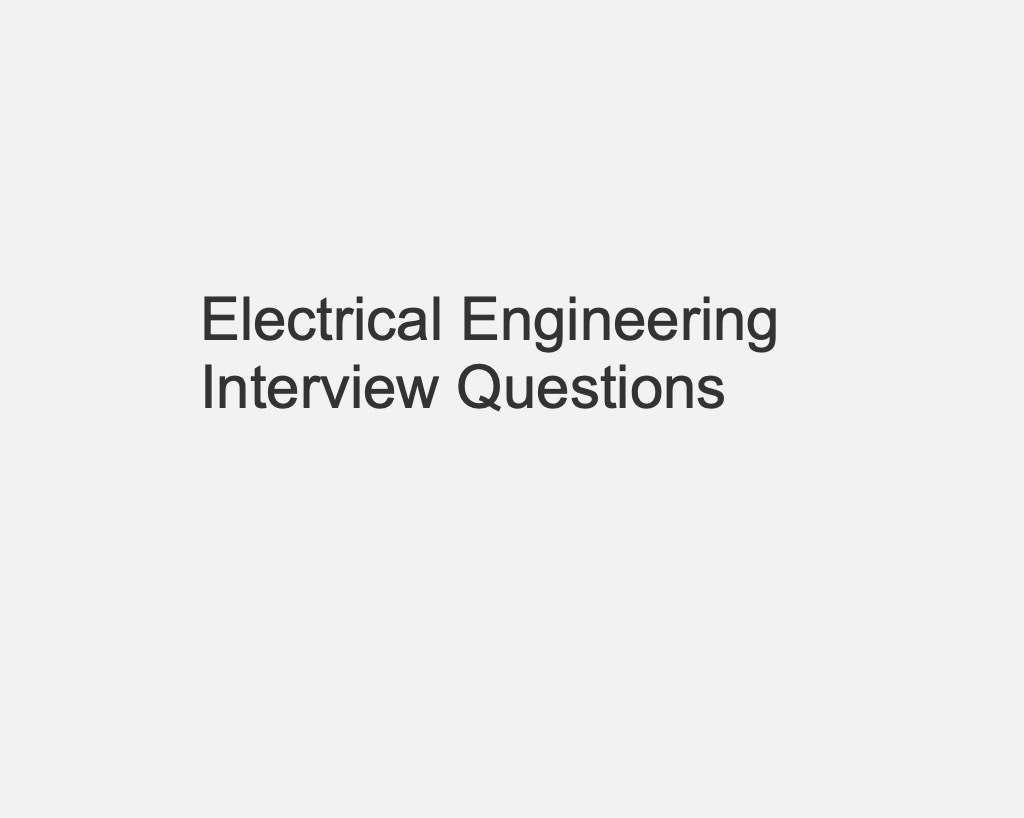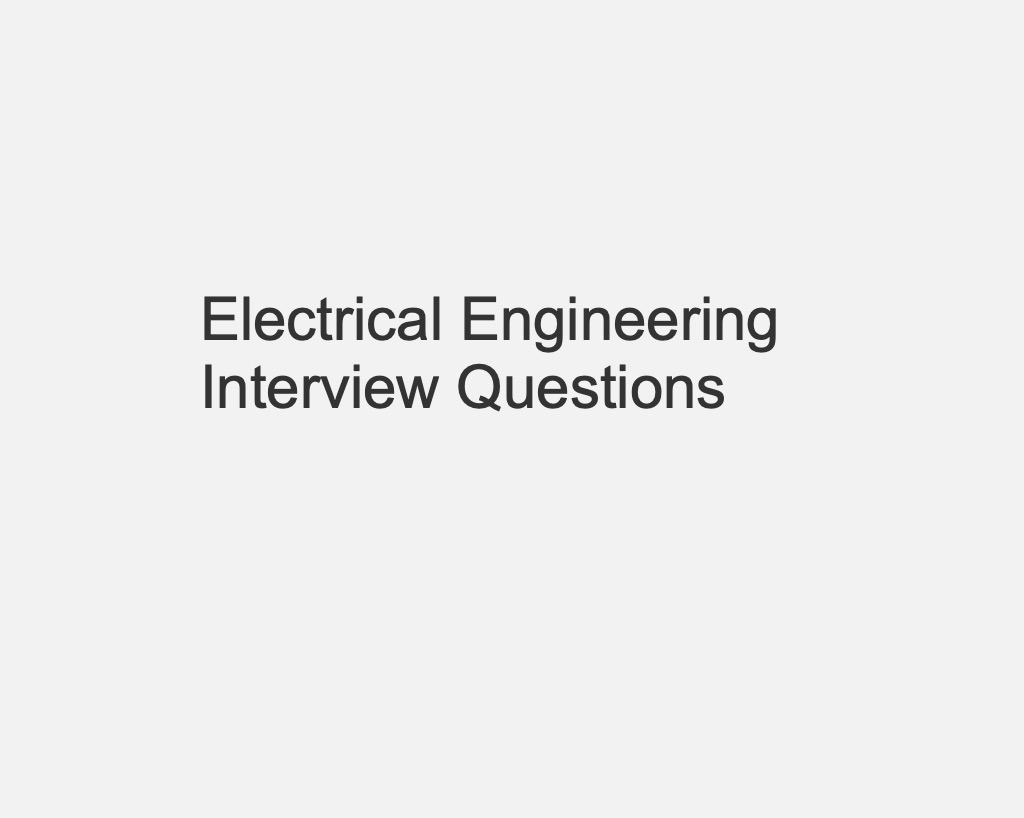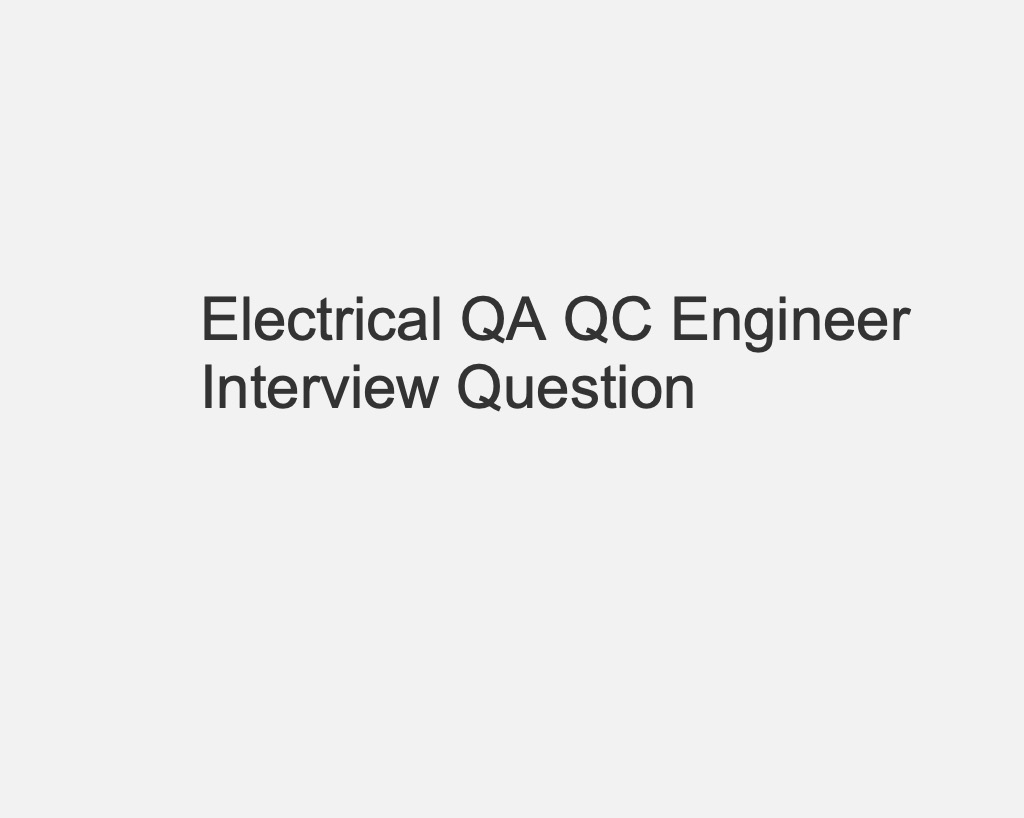Electrical Engineering Interview Questions – Part 2
What is the purpose of a lockout relay in high voltage?
A lock-out relay is typically installed before or after the e-stop switch to allow electricity to be turned off from a single location. This relay is activated by a key lock switch and is powered by the same electrical source as the control power. Within the unit, the relay may contain up to 24 contact points. This enables the control power of several devices to be disabled with the flip of a single key switch.
What is a reverse power relay?
Reverse power flow relays are used to protect generating stations. A generating station is designed to feed power to the grid, and if the generating units are turned off and no generation occurs in the plant, the plant may draw power from the grid. We utilise reverse power relay to block the flow of power from the grid to the generator.
What is the meaning of the electrical diversity factor in electrical installations?
The electrical diversity factor is the ratio of the sum of the individual maximum demands of distinct subdivisions of a system or part of a system to the total maximum demand of the system or part of the system under consideration. Electrical diversity is frequently more than one.
Explain What is the rated speed?
The speed of a motor when it is receiving normal current (rated current) is referred to as its rated speed. It is the pace at which any system can use a tiny amount of current while being efficient.
What is inrush current?
The current drawn by an electrically driven device when electricity is first provided is known as inrush current. It can happen with AC or DC powered equipment and even with low supply voltages.
Why are transformer ratings in KVA?
Because transformer power factor is load dependent, we just define VA rating and exclude power factor.
In the case of motors, power factor is determined by construction, hence motor ratings are in KW and include power factor.
What is the difference between a fuse and a breaker?
When there is an overcurrent flow in the circuit, fuses are consumed, while breakers are just open (not burned). Fuses are only used once, whereas breakers are used several times.
Stepper motor definition What is the function of a stepper motor?
A stepper motor is a motor that works or acts on the applied input pulse. This stepper motor is classified as a synchronous motor, which does not always rely on the entire cycle. It prefers to work in any direction when it comes to stages. It is primarily utilised in automation parts for this purpose.
What is the difference between delta-delta, delta-star transformer?
Delta-delta transformers are employed at generating stations or receiving stations to change the voltage (i.e., where the voltage is high and the current is low).
Delta-star transformers are distribution transformers in which the secondary star neutral is employed as a return path, and this arrangement is used for step down voltage phenomenon.
What is electric traction?
Traction refers to the use of electric power in traction systems, such as railways, trams, and trolleys. Electric traction entails the use of electricity for all of these purposes. Magnetic traction is now also used in bullet trains. Electric traction systems mostly employ dc motors.
What is the purpose of biased or percentage differential protection?
A standard circulating current differential protection cannot be applied to a transformer due to considerations such as ratio, tap position, and magnetising inrush, among others. As a result, the percentage bias must be included in the differential circuit.
How can we regulate the voltage of the generator?
The terminal voltage of an isolated generator is determined by the stimulation on the rotor field winding. An automatic voltage regulator that adjusts the field current generally keeps the generator output terminal voltage at the proper level.
How can DC power be generated?
Direct current power is mostly required for particular loads such as electrochemical processes, railway electrification, cranes, automotive equipment, and elevators. Direct current power can be created directly, although it is more typically obtained via converting or rectifying alternating current electricity near the demand.
What is a turbo alternator?
Turbo alternators are a type of high-speed alternator. Because of the high rotational speed, the rotor diameter is reduced while the axial length is raised. In most cases, two or four poles are employed, and steam turbines are used as primary movers.
Name the various types of rotors used in the alternators
Salient pole rotor.
Non- salient pole rotor or cylindrical rotor.
What is a pole pitch?
Pole pitch is the distance between the centres of two adjacent poles. 180 electrical degrees are equal to one pole pitch. It can also be expressed as the number of slots per pole.
What is meant by the relay’s reach point?
The reach point is the farthest point from the relay location that is still within the zone of protection.
What is the difference between a fuse and a circuit breaker?
When there is an overcurrent in the circuit, the fuses burn out, but the circuit breaker only opens. Thus, fuses are only used once, whereas breakers can be used several times.
Name the types of circuit breakers?
Air break circuit breaker.
Oil circuit breaker.
Minimum oil circuit breaker.
Air blast circuit breaker.
Vacuum circuit breaker.
SF6 circuit breaker.
What exactly are symmetrical elements?
It’s a mathematical tool for converting unbalanced components into balanced ones.
Explain the terms actual power, apparent power, and reactive power for alternating current circuits?
Real power is the product of voltage, current, and power factor,
i.e., P = V I cos ø,
and the basic unit of real power is watt.
The product of voltage and current is apparent power. Apparent power = V I, and the fundamental unit of apparent power is the volt-ampere. VA is abbreviated as KVA.
Reactive power is the product of voltage, current, and the sine of the angle between the voltage and current, i.e., Reactive power = voltage X current X sin ø or Reactive power = V I sin ø and is given in VAR or KVAR.
What are the negative sequence components?
It has three vectors of equal magnitude but separated by a 120-degree angle, and its phase sequence is the inverse of its original phasors.
What is a protected zone?
A protected zone is one that is directly protected by a protective system such as relays, fuses, or switchgear. If a failure occurs in a zone, it can be recognised and/or isolated quickly by a protection scheme specialised to that zone.
What is meant by are arcing grounds?
The existence of inductive capacitive currents in the isolated neutral system causes arcing grounds to occur.
What are the different sorts of unsymmetrical faults?
Unsymmetrical faults include:
line to ground faults,
line to line faults, and
double line to ground faults.
What are the many kinds of power in electrical power?
In electrical power, three types of power are typically counted. They do,
Apparent power
Active power
Reactive power
What is a single line diagram?
A single line diagram is defined as the representation of numerous power system components in a single diagram.
What is a surge absorber? What distinguishes them from surge diverters?
Surge absorbers are devices that are used to protect electrical equipment against transitory high voltages by limiting the duration and amplitude of the following current. Surge diverters discharge impulse surges to the earth, dissipating energy as heat.
What factors influence the quality factor in resonance?
The quality factor q is affected by frequency and bandwidth.
What is an arc suppression coil?
A reactance grounding method used to prevent the arc caused by arcing grounds.
What is the importance of a double line fault?
It has no zero sequence components and connects the positive and negative sequence networks in parallel.
What are the benefits of a VSCF wind energy system?
The following are the benefits of a VSCF wind electrical system:
There is no need for a complicated pitch-changing system.
The aero turbine is always operating at full efficiency.
Extra energy can be derived from the speed – duration curve in the high wind speed zone.
Aerodynamic stresses associated with constant-speed operation are significantly reduced.
What is ACSR cable and what is the use?
ACSR means Aluminium conductor steel reinforced, this conductor is used in transmission & distribution.
Name the various kind of cables used for transmission?
Cables, which are used for transmitting power are mainly classified into three types. They are:
Low-tension cables, which can transmit voltage up to 1000 volts.
High-tension cables can transmit voltage up to 23000 volts.
Super tension cables can transmit voltage 66 kV to 132 kV.
What is the definition of slip in an induction motor?
The difference between the flux speed (Ns) and the rotor speed is defined as slip (N). the synchronous speed of an induction motor is always greater than the rotor speed. It is commonly expressed as a percentage of synchronous speed (Ns) and denoted by the sign ‘S.’
What is the amplifier’s voltage gain or transfer function?
Vout/Vin
Define Thevenin’s Theorem
According to thevenin’s theorem, the current flowing through a load resistance Connected across any two terminals of a linear active bilateral network is the ratio open circuit voltage (i.e. the voltage across the two terminals when RL is removed) and sum of load resistance and internal resistance of the network. It is given by Voc / (Ri + RL).
What does the KVAR means?
The KVAR indicates the electrical power. KVAR means “Kilo Volt Amperes with Reactive components”
What is the difference between MCB and MCCB?
A miniature circuit breaker (MCB) is a thermally powered circuit breaker used for short circuit protection in circuits with low current ratings. MCCB is a moulded case circuit breaker that is thermally operated for over load current and magnetically driven for instant trip in the event of a short circuit. Undervoltage and underfrequency may be pre-installed. It is typically utilised where usual current exceeds 100A.
Why is the VCB used in High Transmission Systems? Why can’t ACB be used?
Actually, vacuum has a higher arc quenching property than air since the die electric strengths in VCB are 8 times that of air. That is why vacuum is always utilised as an HT breaker and air is used as an LT breaker.
What do the terms “insulation coordination” mean?
Grading of the withstand level of apparatus/equipment with surge arrester protection levels and coordination at the full voltage level and numerous other voltage levels.
What are the various types of overcurrent relays?
Non-directional overcurrent induction relay, directional overcurrent induction relay, and current differential relay
Define the relay’s reset time?
It is defined as the time it takes the relay from the moment the fault is isolated to the moment the fault is gone and the relay can be reset.
Please name two differential relay applications.
Generator and generator transformer unit protection; big motor and bus bar protection
What is an under-frequency relay?
An under-frequency relay activates when the frequency of the system (often an alternator or transformer) goes below a specified threshold.
What are the mechanical losses in a transformer?
The alternating magnetic field generates fluctuating electromagnetic forces between the wire coils, the core, and any nearby metalwork, resulting in vibrations and noise that drain power.
What are the applications of distribution transformers?
Because the distribution transformer is directly connected to the consumer, load fluctuations are extremely significant.
Because the distribution transformer is not fully loaded at all times, iron losses occur 24 hours a day, while Cu losses occur based on the load cycle.
Define maximum power transformer efficiency?
Because it is so close to the generating station, the power transformer is built for maximum efficiency at full load.
How can we improve the power factor?
Methods for increasing the power factor:
By connecting static capacitors in parallel with the lagging power factor load.
When overexcited, a synchronous motor takes a leading current and hence behaves like a capacitor.
Induction motor power factor can be improved by employing phase advancers. It supplies thrilling ampere turns to the motor’s rotor circuit. The induction motor can be made to operate on leading power factor like an overexcited synchronous motor by giving more ampere-turns than required.
Why is back emf used in dc motors?
Back emf is the induced emf produced when the revolving conductors of the armature between the poles of a magnet in a DC motor cut the magnetic flux and oppose the current flowing through the conductor as the armature rotates. Its value is determined by the rotational speed of the armature conductors. The initial value of back emf is zero.
What’s the difference between a surge arrestor and a lightning arrestor?
Outside, a lightning arrestor is installed, and the influence of lightning is grounded, but a surge arrestor positioned inside panels, made up of resistors, consumes the energy and cancels out the effect of the surge.
How can you connect power engineering and electrical engineering?
Electrical engineering is a subset of power engineering. It is concerned with the generation, transmission, and distribution of electrical energy. Power engineering also includes the design of all power equipment. Power engineers may work on the design and maintenance of the power grid, referred to as on grid systems, or on off grid systems, which are not connected to the system.
What is the operation of thermal power plants?
The water is obtained in the boiler, and the coal is burned to produce steam, which is then permitted to hit the turbine, which is paired with the generator to generate power.
What is the MARX CIRCUIT?
It is used with generators to charge and discharge a series of capacitors in parallel. It is utilised when the required voltage for testing is greater than the available voltage.
What is an encoder and how does it work?
An encoder is a device that converts a signal (such a bit stream) or data into a code. The code could be used for a variety of purposes, including compressing data for transmission or storage, encrypting or adding redundancy to the input code, or translating from one code to another. This is normally accomplished by the use of a programmed algorithm, especially if any part is digital, whereas most analogue encoding is accomplished through the use of analogue circuitry.
What is the frenzied effect?
The output voltage exceeds the input voltage, or the receiving end voltage exceeds the transmitting end voltage.
Why can’t a series motor be started with no load?
Because of the large starting torque, a series motor cannot be started without a load. Series motors are used in trains, cranes, and other applications.
What is the definition of percent impedance voltage?
The percent impedance is the percentage of voltage necessary to circulate rated current through one transformer winding when another winding is short-circuited at the rated voltage tap at the rated frequency. This voltage drop is caused by winding resistance and leakage reactance.
What is a creepage?
Current flowing between two conductors along a surface with both conductors in contact. In general, this can be ignored until the voltage reaches a point where corona or flashover occurs.
What is the value of the polarisation index?
It is the ratio of installation resistance (IR) for 0 min to insulation resistance for min. It ranges from 5-7 for a new motor and should be greater than 0.5 for a motor in good condition.
What does insulation voltage in cables mean?
It is a cable property that allows it to withstand applied voltage without rupturing. It is referred to as the cable’s insulation level.
Why do capacitors only function on alternating current?
In general, a capacitor provides an infinite resistance to a DC component (i.e. block the DC components). It permits the alternating current components to pass through.
Name the types of DC generator?
DC generator are mainly classified into two types. They are:
Separately excited DC generator
Self-excited DC generator
What is an exciter and how does it work?
Exciters are classified into two categories. Rotatory exciter and static exciter The exciter’s purpose is to give the excitation DC voltage to the generator’s fixed poles.
What are the different types of cooling systems in a transformer?
ONAP (oil natural, air natural) ONAF (oil natural, air forced) OFAF (oil forced, air forced) ODWF (oil direct, water forced) OFAN (oil forced, air natural)
What does anti-pumping in a circuit breaker do?
When the breaker is closed by the close push button all at once, the anti-pumping contactor prevents the breaker from being closed again by the close push button if it has previously been closed.
What is power factor?
The ratio of genuine power to visible power should ideally be one. If it is too low, wires will overheat and equipment will be overloaded. If it is more than one, the load will function as a capacitor, feeding the source and causing tripping. In order for the system to run smoothly, the power factor should be high. Low power factor indicates more losses.
What is the difference between an isolator and a circuit breaker?
Isolators are off-loaded devices that are used to isolate downstream circuits from upstream circuits in order to perform maintenance on the downstream circuit. Unlike a circuit breaker, it is actuated manually and does not contain a solenoid. It should not be operated when under load; instead, the load should be reduced to zero before it may be operated safely. Only the rated current is specified in its specifications. However, a circuit breaker is an on-load automatic device that is used to break the circuit in the event of abnormal conditions such as a short circuit, overload, and so on. It has three specifications.
Explain frantic effect?
The output voltage exceeds the input voltage, or the receiving end voltage exceeds the transmitting end voltage.
Why is temperature rise carried out in bus bars and isolators?
Bus bars and isolators are designed for continuous power flow, which means they carry a high current, raising their temperature. As a result, these devices must be tested for temperature rise.
Hobo is an electrical engineer with 10 years of work experience, mainly responsible for designing, developing and maintaining electrical systems and equipment.













